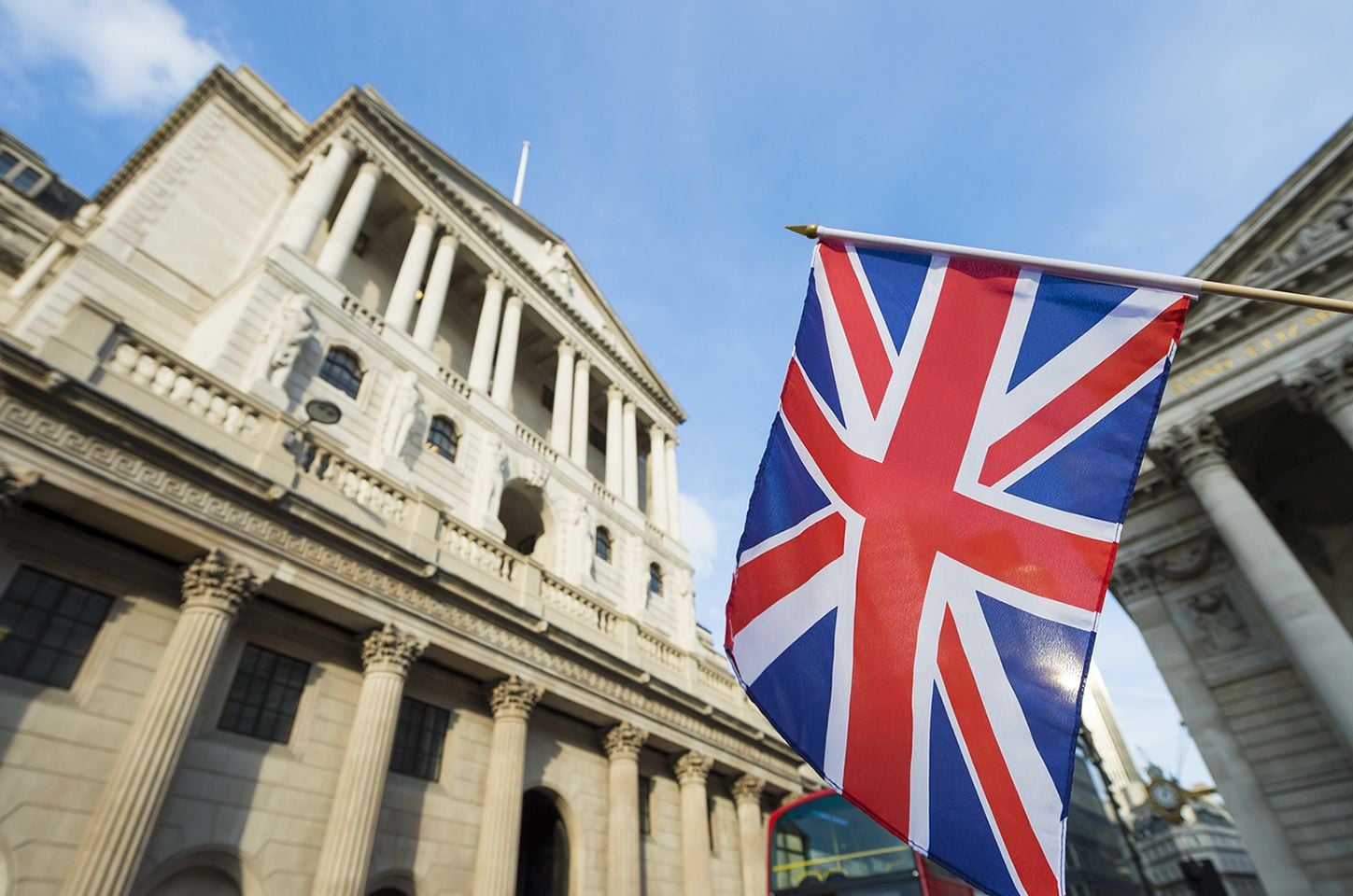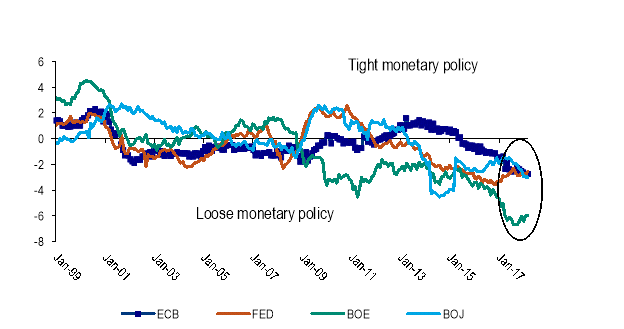Warnings that British Pound's Purple Patch Against the Euro & Dollar has a Limited Shelf-Life
- Bank of England interest rate expectations firing the Pound higher
- Yet, "situation for Sterling exchange rates remains tense" says one analyst
- Analysts say Pound's current strong run will ultimately fade

Above: The Bank of England is a prime engine of Sterling's current rally, but for how long? Image © lazyllama, Adobe Stock
The Pound's good run might be fleeting warn analysts who have identified the key driver of recent strength as having a potentially limited shelf-life.
While Sterling has given back some recent gains at the time of writing, the British Pound ultimately finds itself in a 'purple patch' this April as it trades at its highest level against the US Dollar since the Brexit referendum, having achieved 1.4376 on Tuesday, April 17.
Against the Euro, we have seen Sterling testing 11 month highs, while the UK currency also enjoyed gains against a host of rivals. In fact, in 2018 the Pound is the best-performing major currency.
A more benign Brexit environment is certainly one factor driving the move, but "monetary policy clearly constitutes an important driver for Sterling strength," says Thu Lan Nguyen, a foreign exchange analyst at Commerzbank.
Therefore, those questioning whether Sterling's strength can continue need to ask whether the Bank of England story can continue offering that support, and whether or not other factors might soon come to play in determining the currency's value.
The interest rate set by central banks has long been on of the most significant drivers of currencies as global money tends to hunt out higher interest rates; those regions that have high interest rates, or are expected to enjoy higher rates in the foreseeable future, tend to command a stronger currency.
And now could be Sterling's time to shine as the Bank of England is currently seen engaged in the early throes of an interest rate raising cycle.
"Another Bank of England rate hike in May is now almost completely priced in by the markets. And in fact our UK expert only recently adjusted his forecast and now expects further rate steps at 6 monthly intervals," says Nguyen, pointing out the crucial point that future interest rate are seen.
Your opinion on how quickly future rate rises will be delivered is likely to influence how you see the Pound performing.
Most economists now expect just one Bank of England interest rate this year https://t.co/RATkqyAJcX pic.twitter.com/ruV8VcmYf4
— Bloomberg Brexit (@Brexit) April 17, 2018
"While the rate hike last year could still be seen as taking back the pre-emptive rate cut in the immediate aftermath of Brexit the further rate path can now be seen as an actual rate hike cycle. If the UK data, like today’s labour market report, does not disappoint massively, Sterling can expect further support on the monetary policy front," says Nguyen.
Labour market data released on April 17 proved to be a mixed bag for the Pound: while both wages and employment are rising, the pick-up in wages at 2.8% was below economist forecasts for a rise of 3.0%. This prompted Sterling to ease back from recent highs, however the market appears to maintain the solid belief that the data is enough to encourage the Bank to raise rates again after May.
"Markets seem to be focusing more on potential for monetary policy tightening than on what central banks are actually doing," says Athanasios Vamvakidis, head of G10 FX strategy at Bank of America Merrill Lynch. "Our results suggest that global monetary policies remain very loose, despite hikes/less loosening; the BoE and Riksbank are the two G10 central banks with, by far, the loosest monetary policies and therefore the most room to tighten.”
There is a clear view held by some that the extraordinarily low interest rates at the Bank of England could ultimately cause more damage to the economy in the longer-run as such scenarios have an history of stoking bubbles. There is a strong argument being made that the economy can handle further rate rises without compromising on growth, and waiting too long to raise rates is dangerous.
This month saw Bank of England Monetary Policy Committee Member Ian McCafferty urge his colleagues on the MPC to hurry up and start raising interest rates. In an interview with Reuters on Tuesday, April 10 McCafferty urged fellow members of the rate-setting committee of the Bank should "stop dallying" over raising interest rates.
"Sterling is up again and remains bid," says Neil Jones an analyst at Mizuho Bank citing "comments from Mccafferty that the BOE mustn't 'dally' any further over raising interest rates. That, along with an improved global backdrop as well as seasonal demand are supporting the Pound."
The Pound is meanwhile forecast by analysts at global investment bank Rabobank to advance further on the Euro over coming weeks as the Bank of England elbows Brexit aside to become the predominant driver of Sterling exchange rates.
"Brexit-related news continues to rumble on but, in the approach to the May 10 BoE policy meeting, it could be the outlook for monetary policy that takes the upper hand in guiding the outlook for the Pound,” says Jane Foley, a currency strategist at Rabobank.
But, the Party Must End
While the Bank of England's interest rate policy story remains broadly supportive of the Pound, it must be remembered that the drivers of exchange rates can often shift in importance.
And there is no shortage of foreign exchange practitioners out there who maintain a cautious stance on Sterling in light of the difficult Brexit negotiations that will characterise coming months.
"The main risk for the British currency remains Brexit though. However, the market seems to be ignoring this, which is quite a courageous step if one considers the latest comments on both negotiating sides. No agreement has been reached on the question of the Irish border. And without that an exit agreement and thus an agreement on a transition period remain impossible. The situation for Sterling exchange rates remains tense," warns Nguyen.
Indeed, Commerzbank are forecasting the Pound-to-Dollar exchange rate to end 2018 at 1.36 which is substantially lower from the 1.43s we are seeing at the present time. However they are forecasting the Pound-to-Euro exchange rate to end the year at 1.1760 which suggests some upside from here, even if it is not in a straight line.
Rabobank are also cautious on Sterling over coming months owing to Brexit negotiations, even if they do see the Bank of England delivering a near-term fillip for the currency.
“As the summer months approach, we see scope for concern about the progress of Brexit trade talks to weigh on the Pound and see risk for EUR/GBP to edge towards 0.89 on a 3 month view. That said, it is our house view that the bones of a free trade deal will be in place by March 2019. We expect that this should spark a push back to 0.84 on a 12 month view,” says Foley.
EUR/GBP at 0.89 gives a Pound-to-Euro exchange rate of 1.1235 while 0.84 give an exchange rate of 1.19. So their forecast profile could be summarised as: up, down and back up.
Amundi - the asset manager that boasts €1.4 trillion worth of assets under management - have meanwhile warned clients the British Pound faces significant downside should the kind of Brexit deal they are expecting be delivered.
"Our base case scenario foresees an intermediate relationship, with free trade in goods but only very partial passporting in financial services," says Didier Borowski, Head of Macroeconomic Research at Amundi, Europe's largest asset manager.
This deal for passporting is crucial owing to the significant portion of export revenue generated by financial services and Amundi warn their base-case envisages the UK ending up with less passporting rights than Switzerland currently enjoys.
The risk that financial service activity fades following Brexit and is a key factor why Amundi are forecasting the Pound-to-Euro exchange rate to fall below 1.0, which currently makes them the most bearish institution when it comes to Sterling.





